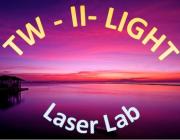Friedland, L., Marcus, G., Wurtele, J.S. & Michel, P. Excitation and control of large amplitude standing ion acoustic waves.
Physics of Plasmas 26, 9, 092109 (2019).
Publisher's VersionAbstractWe study the formation of large-amplitude standing ion acoustic waves (SIAWs) by nonlinear phase-locking (autoresonance) with a weak, chirped frequency standing ponderomotive drive. These waves comprise a nonlinear two-phase solution, with each phase locked to one of the two traveling waves comprising the drive. The autoresonance in the system is guaranteed provided that the driving amplitude exceeds a threshold. The phenomenon is illustrated via water bag simulations within a nonlinear ion fluid model and analyzed using Whitham's averaged variational principle. The local ion and electron densities in the autoresonant SIAWs may significantly exceed the initial unperturbed plasma density and are only limited by kinetic wave-breaking.
Appeared also in SciLight
 full_text.pdf
full_text.pdf Komm, P., Sheintop, U., Noach, S. & Marcus, G. Carrier-to-envelope phase-stable, mid-infrared, ultrashort pulses from a hybrid parametric generator: Cr:ZnSe laser amplifier system.
Opt. Express 27, 13, 18522–18532 (2019).
Publisher's VersionAbstractOur Cr:ZnSe laser amplifier, seeded by parametric difference mixing, produces 72fs long pulses at the central wavelength of 2.37&\#x00B5;m. The stability of the carrier-to-envelope phase of the amplified seed pulses, attained at the stage of their parametric generation, is preserved through 6 orders of magnitude of laser amplification.
 full_text.pdf
full_text.pdf Sheintop, U., et al. Two-wavelength Tm:YLF/KGW external-cavity Raman laser at 2197 nm and 2263 nm.
Opt. Express 27, 12, 17112–17121 (2019).
Publisher's VersionAbstractThis paper presents a KGW Raman laser with an external-cavity configuration at the 2 &\#x00B5;m region. The Raman laser is pumped by an actively Q-switched Tm:YLF laser, especially designed for this purpose emitting at 1880 nm. Due to the KGW bi-axial properties, the Raman laser is able to lase separately at two different output lines, 2197 nm and 2263 nm. The output energies and pulse durations that were achieved for these two lines are 0.15 mJ/pulse at 21 ns and 0.4 mJ/pulse at 5.4 ns, respectively. To the best of our knowledge, this is the first time that the KGW crystal, which is well known for its wide use in shorter wavelengths, is demonstrated in a Raman laser in the 2 &\#x00B5;m region. According to the achieved results and due to the KGW properties, it appears to be a suitable crystal for energy scaling and efficient Raman conversion in this spectral range. An estimation of the Raman gain coefficient for this wavelength is provided as well.
 full_text.pdf
full_text.pdf Sobolev, E., Komm, P., Noah, S. & Marcus, G. Parametric amplification in large-aperture diffusion-bonded periodically poled crystals.
Opt. Lett. 44, 5, 1261–1264 (2019).
Publisher's VersionAbstractWith conventional poling techniques of pyroelectric crystals, the thickness of the periodically poled crystals is typically limited to 0.5&\#x2013;1&\#x00A0;mm. Such a small aperture of the crystal limits the amount of energy/power that this device may deliver. Here we discuss diffusion bonding as an alternative method to achieve a wider periodically poled crystal, with virtually unlimited width. It is shown that the amplified signal preserved a good beam profile despite a possible phase shift between the stitched crystals. This technique may be extended to larger aperture optical parametric amplifiers and allows for high energy output from periodically poled crystals.
 Full_Text.pdf
Full_Text.pdf 
